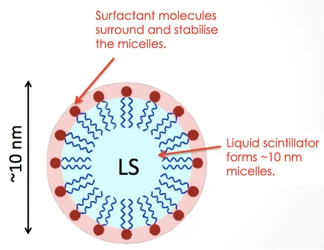ANNIE: The Accelerator Neutrino Neutron Interaction Experiment
The Accelerator Neutrino Neutron Interaction Experiment (ANNIE) is a 26-ton water-based neutrino detector at Fermilab on the Booster Neutrino Beam (BNB), small by particle physics standards but with big ambitions. The goal of the effort is to develop a next-generation neutrino detector using advanced photosensors and new experimental techniques, all while making important progress in understanding how neutrinos interact with matter. Measurements of final-state neutron multiplicity from neutrino-nucleus interactions will improve our understanding of the complex, many-body dynamics of neutrino-nucleus interactions and thus help to reduce dominant systematics on future long-baseline neutrino oscillation measurements.
Identifying and counting final state neutrons also provides a useful experimental handle for signal-background separation in future neutrino experiments. Two enabling technologies make this measurement possible: (1) the first application of Large Area Picosecond Photodetectors (LAPPDs), which will allow detailed timing-based reconstruction of the primary neutrino interaction, and (2) the first use of gadolinium-enhanced water on a high energy neutrino beam to efficiently count final-state neutrons. Phase I of ANNIE, designed to provide a measurement of critical neutron backgrounds, was successfully completed in 2017. Phase II detector for the full physics program of the experiment was installed in July 2019 and data taking was started in 2020. We have installed multiple LAPPDs and have done a test run with Water-based Liquid Scintillator (WbLS) in the SANDI vessel in 2023.
WbLS: Water-based Liquid Scintillator
ANNIE is investigating WbLS as a novel target material for enhanced event reconstruction of GeV neutrinos. WbLS is optimized for the co-detection of Cherenkov and scintillation signals. Small droplets (micelles) of organic scintillator with a hull of surfactant molecules are suspended in water that serves as the bulk material. While regular organic scintillator absorbs most of the Cherenkov spectrum, WbLS with a large water fraction (99%) is very transparent so that a large fraction of the Cherenkov photons can reach the photo sensors unimpeded.
Adding the scintillation signal means that particles below the Cherenkov threshold can be detected, which means that low-energy protons and other hadrons emitted at the neutrino interaction vertex become visible. This will improve both the energy and the spatial reconstruction of the neutrino reaction. The Cherenkov cone can be discriminated from the isotropically emitted scintillation photons based on the angular distribution of photons detected. Moreover, the early Cherenkov photons can be distinguished from the scintillation photons that are emitted with several nanoseconds delay. Therefore, ANNIE is an ideal test bed for the novel technique: WbLS can be used as a target medium in the center of the detector tank while the PMTs and crucially the ultra-fast LAPPDs can be used to discriminate Cherenkov and scintillation signals.In spring 2023, we suspended a small volume (365 kg) of WbLS in a cylindrical acrylic vessel dubbed SANDI in the detector center.
During the 2-month measurement with SANDI, we detected hundreds of neutrino interactions and Michel electrons from muon decay within the WbLS volume. Based on this data, we were able to establish the clear presence of a scintillation signal (on top of the Cherenkov cone) and estimate the scintillation light output to about 80% of the Cherenkov intensity. A further test run with gadolinium-loaded WbLS in SANDI is planned for 2024, while a year-long data run with a substantially larger WbLS-filled vessel that takes up the entire detection volume is foreseen for 2026.
Contact
For collaboration, thesis opportunities, or further inquiries, please contact:
Dr. rer. nat. Hans Steiger
- Tel.: +49 (89) 289 - 51320
- hans.steiger@tum.de
